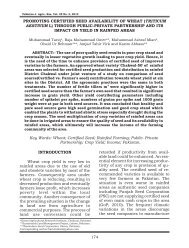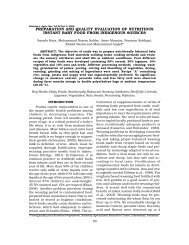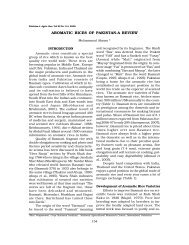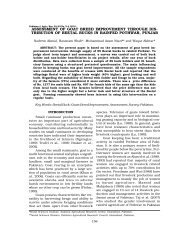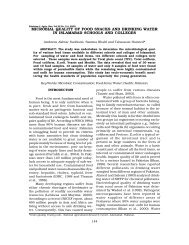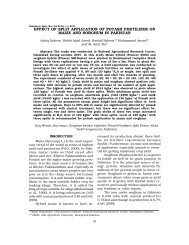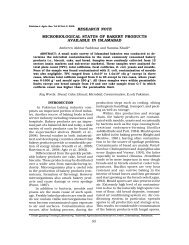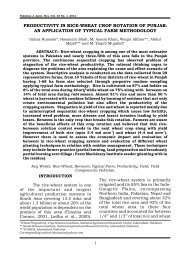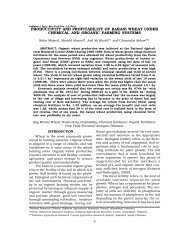efficiency of lattice design in relation to randomized complete ... - PJAR
efficiency of lattice design in relation to randomized complete ... - PJAR
efficiency of lattice design in relation to randomized complete ... - PJAR
Create successful ePaper yourself
Turn your PDF publications into a flip-book with our unique Google optimized e-Paper software.
Pakistan J. Agric. Res. Vol 22 No. 3-4, 2009.<br />
EFFICIENCY OF LATTICE DESIGN IN RELATION TO RANDOMIZED<br />
COMPLETE BLOCK DESIGN IN AGRICULTURAL FIELD<br />
EXPERIMENTS<br />
Irum Raza and M. Asif Masood*<br />
ABSTRACT: This study was conducted <strong>to</strong> compare the relative <strong>efficiency</strong> <strong>of</strong><br />
two statistical experimental <strong>design</strong>s based on mean square errors. For this purpose,<br />
three datasets were analyzed with Lattice <strong>design</strong> and <strong>randomized</strong> <strong>complete</strong><br />
block <strong>design</strong> (RCBD). The results <strong>of</strong> the first dataset show that 26% precision<br />
<strong>in</strong>creased with Lattice <strong>design</strong> over RCBD. Coefficient <strong>of</strong> variation <strong>of</strong> <strong>lattice</strong> <strong>design</strong><br />
is 19% while that <strong>of</strong> RCBD is 21%, which proves the <strong>efficiency</strong> <strong>of</strong> Lattice<br />
<strong>design</strong>. In addition, larger F- value <strong>of</strong> Lattice <strong>design</strong> <strong>in</strong>dicates greater variability<br />
among the treatments as compared <strong>to</strong> RCBD. Results <strong>of</strong> the second dataset signify<br />
that Lattice <strong>design</strong> <strong>in</strong>creases the precision <strong>of</strong> experiment by 17% and also shows<br />
less coefficient <strong>of</strong> variation than RCBD which implies that <strong>lattice</strong> <strong>design</strong> is aga<strong>in</strong><br />
more efficient. In third dataset, Lattice <strong>design</strong> is aga<strong>in</strong> more efficient than RCBD<br />
<strong>in</strong> terms <strong>of</strong> relative <strong>efficiency</strong> (55%) and c.v (7%). The relative efficiencies <strong>of</strong><br />
three datasets were 26%, 17% and 55%, respectively, and specify that the precision<br />
<strong>of</strong> experiment <strong>in</strong>creased significantly us<strong>in</strong>g Lattice <strong>design</strong>.<br />
Key Words: Complete Block Design; In<strong>complete</strong> Block Design; Randomized Complete<br />
Block Design; Lattice Design; Relative Efficiency; Coefficient <strong>of</strong> Variation; Pakistan.<br />
150<br />
INTRODUCTION<br />
Experimentation plays a momen<strong>to</strong>us<br />
role <strong>in</strong> the field <strong>of</strong> agriculture. A good experiment<br />
is the one which <strong>in</strong>volves good<br />
plann<strong>in</strong>g, accurate data collection, proper<br />
data analysis and precise <strong>in</strong>terpretation <strong>of</strong><br />
the data. A statistician is supportive <strong>in</strong><br />
draw<strong>in</strong>g <strong>in</strong>ferences and conclusions from<br />
the experiment however, before that the<br />
researcher must properly def<strong>in</strong>e the objectives<br />
<strong>of</strong> the experiment.<br />
Experimental <strong>design</strong>s are basically divided<br />
<strong>in</strong><strong>to</strong> two categories: <strong>complete</strong> block<br />
<strong>design</strong>s and <strong>in</strong><strong>complete</strong> block <strong>design</strong>s.<br />
Complete block <strong>design</strong>s <strong>in</strong>clude <strong>complete</strong>ly<br />
<strong>randomized</strong> <strong>design</strong> (CRD), RCBD, Lat<strong>in</strong><br />
squares etc. Among these <strong>design</strong>s, RCBD<br />
is one <strong>of</strong> the most extensively used <strong>design</strong>s<br />
<strong>in</strong> agriculture.<br />
In RCBD blocks size should be homogeneous<br />
and each block must conta<strong>in</strong> a<br />
<strong>complete</strong> set <strong>of</strong> treatments. It also reduces<br />
experimental error through proper block<strong>in</strong>g<br />
though block<strong>in</strong>g becomes <strong>in</strong>effective<br />
when the block size <strong>in</strong>creases and cannot<br />
be used for a large number <strong>of</strong> treatments.<br />
Therefore <strong>in</strong> such a situation, RCBD becomes<br />
less powerful <strong>in</strong> controll<strong>in</strong>g experimental<br />
error due <strong>to</strong> soil heterogeneity <strong>in</strong><br />
experimental site.<br />
Patterson et al. (1978) suggested that<br />
if block<strong>in</strong>g is not done properly then <strong>lattice</strong><br />
<strong>design</strong>s can be analyzed as RCBD by consider<strong>in</strong>g<br />
super blocks as ord<strong>in</strong>ary blocks.<br />
These <strong>design</strong>s do not necessitate the number<br />
<strong>of</strong> blocks <strong>to</strong> be equal <strong>to</strong> the number <strong>of</strong><br />
replications although the replication is further<br />
divided <strong>in</strong><strong>to</strong> smaller blocks and then<br />
treatments are assigned <strong>to</strong> these blocks.<br />
Another advantage <strong>of</strong> <strong>in</strong><strong>complete</strong> block <strong>design</strong><br />
is that it can be used for any number<br />
<strong>of</strong> treatments and replications.<br />
Yates (1936 b) launched an important<br />
type <strong>of</strong> <strong>in</strong><strong>complete</strong> block <strong>design</strong> named ‘Lattice<br />
<strong>design</strong>s’. These <strong>design</strong>s were <strong>in</strong>itially<br />
termed as pseudo-fac<strong>to</strong>r <strong>design</strong>s and were<br />
capable <strong>of</strong> provid<strong>in</strong>g efficient <strong>in</strong><strong>complete</strong><br />
block <strong>design</strong>s for unstructured treatments<br />
by <strong>in</strong>flict<strong>in</strong>g artificial pseudo-fac<strong>to</strong>r on the<br />
treatments and then confound<strong>in</strong>g the contrasts<br />
between blocks.<br />
Lattice <strong>design</strong>s are now frequently<br />
used <strong>in</strong> the field <strong>of</strong> agriculture <strong>to</strong> test the<br />
yield <strong>of</strong> annual crops. A condition required<br />
*Social Sce<strong>in</strong>ces Institute, National Agricultural Research Centre, Islamabad, Pakistan.
<strong>in</strong> these <strong>design</strong>s is that the number <strong>of</strong> treatments<br />
used must be a perfect square such<br />
as 5 2 or 25, 6 2 or 36, 7 2 or 49, 8 2 or 64, 9 2 or<br />
81, 10 2 or 100. The two most commonly used<br />
<strong>lattice</strong> <strong>design</strong>s <strong>in</strong>clude balanced <strong>lattice</strong> and<br />
partially balanced <strong>lattice</strong>. The discrepancy<br />
between these two <strong>design</strong>s occurs on the<br />
use <strong>of</strong> the number <strong>of</strong> replications. In balanced<br />
<strong>lattice</strong> <strong>design</strong>, block size (k) is equal<br />
<strong>to</strong> the square root <strong>of</strong> the <strong>to</strong>tal number <strong>of</strong><br />
treatments and the number <strong>of</strong> replications<br />
required is one more than the block size<br />
i.e., k+1. However <strong>in</strong> partially balanced <strong>lattice</strong><br />
<strong>design</strong> any number <strong>of</strong> replications can<br />
be used so with two replications the <strong>design</strong><br />
is called a simple <strong>lattice</strong>; with three replications,<br />
a triple <strong>lattice</strong>; with four replications,<br />
a quadruple <strong>lattice</strong>, etc.<br />
Sarker et al. (2001) performed an <strong>in</strong><strong>complete</strong><br />
block analysis <strong>of</strong> 53 lentil yield<br />
trials <strong>in</strong> <strong>lattice</strong> block <strong>design</strong>. In field experiment<br />
spatial variability exists <strong>in</strong> row<br />
and column direction and can be modeled<br />
us<strong>in</strong>g covariance structure for plot errors.<br />
First order au<strong>to</strong> cor<strong>relation</strong> error structure<br />
(AR1) was fitted <strong>in</strong> both the column and row<br />
direction and the best model was selected<br />
on the basis <strong>of</strong> residual deviance <strong>of</strong> 53 trials.<br />
The <strong>efficiency</strong> for the pair wise comparison<br />
<strong>of</strong> genotypes over RCB was obta<strong>in</strong>ed<br />
for the <strong>lattice</strong> blocks and the selected models.<br />
Spatial models were found efficient for<br />
the 74% <strong>of</strong> the trials as compared <strong>to</strong> the<br />
<strong>lattice</strong> blocks. The average <strong>efficiency</strong> <strong>of</strong><br />
spatial models over RCB was 50% at the<br />
analysis stage. The results emphasized<br />
IRUM RAZA AND M. ASIF MASOOD<br />
151<br />
that a comb<strong>in</strong>ed <strong>lattice</strong> and neighbor analysis<br />
<strong>in</strong>crease the <strong>efficiency</strong> <strong>of</strong> experiment.<br />
MATERIALS AND METHODS<br />
To compare the relative <strong>efficiency</strong> <strong>of</strong><br />
RCBD and Lattice <strong>design</strong>, three datasets<br />
conta<strong>in</strong><strong>in</strong>g 3x3 and 4x4 as a balanced <strong>lattice</strong><br />
<strong>design</strong> with 4 and 5 replications respectively<br />
and a 5x5 partially balanced <strong>lattice</strong><br />
<strong>design</strong> with 2 replications were taken<br />
from Gomez and Gomez (1976). Layout and<br />
analysis were obta<strong>in</strong>ed us<strong>in</strong>g the MSTAT-<br />
C s<strong>of</strong>tware.<br />
The <strong>efficiency</strong> <strong>of</strong> Lattice <strong>design</strong> relative<br />
<strong>to</strong> RCBD was based on Intra block error<br />
MS, Effective error MS, F-value and<br />
Coefficient <strong>of</strong> variation (c.v) .The relative<br />
<strong>efficiency</strong> (R.E) was calculated as<br />
R.E = 100 * block (adj.)SS + <strong>in</strong>trablock<br />
error SS / k (k 2 – 1) (effective error MS)<br />
For each dataset, c.v, mean square<br />
errors (MSE) and F-values were studied.<br />
RESULTS AND DISCUSSION<br />
First dataset consisted <strong>of</strong> 9 treatments<br />
and 4 replications and the results revealed<br />
that the relative <strong>efficiency</strong> <strong>of</strong> Lattice compared<br />
with <strong>randomized</strong> <strong>complete</strong> block was<br />
26% (Table 1). Coefficient <strong>of</strong> variation <strong>of</strong><br />
<strong>lattice</strong> <strong>design</strong> was 19% while that <strong>of</strong> RCBD<br />
was 21% which also showed the <strong>efficiency</strong><br />
<strong>of</strong> <strong>lattice</strong> <strong>design</strong>. In addition larger F- value<br />
<strong>of</strong> Lattice <strong>in</strong>dicated greater variability<br />
among the treatments as compared <strong>to</strong><br />
RCBD.<br />
Table 1. Analysis <strong>of</strong> Variance for 3x3 Square Lattice Design<br />
Source <strong>of</strong> Degrees <strong>of</strong> Sum <strong>of</strong><br />
variance freedom squares Mean square F-value Prob<br />
Replications 3 0.077 0.026<br />
Treatments<br />
-Unadjusted 8 3.226 0.403 3.64 0.013<br />
-Adjusted 8 3.172 0.396 4.32 0.006<br />
Blocks with<strong>in</strong><br />
Reps (adj.) 8 1.421 0.178<br />
Error<br />
-Effective 16 1.470 0.092<br />
-RCB Design 24 2.657 0.111<br />
-Intrablock 16 1.237 0.077<br />
Total 35 5.961
EFFICIENCY OF LATTICE DESIGN<br />
Table 2. Analysis <strong>of</strong> Variance for 4x4 Square Lattice Design<br />
Source <strong>of</strong> Degrees <strong>of</strong> Sum <strong>of</strong><br />
variance freedom squares Mean square F-value Prob<br />
Replications 4 5946 1486<br />
Treatments<br />
-Unadjusted 15 26994 1799 4.17 0.000<br />
-Adjusted 15 24001 1600 4.33 0.000<br />
Blocks with<strong>in</strong><br />
Reps (adj.) 15 11382 759<br />
Error<br />
-Effective 45 16620 369<br />
-RCB Design 60 25915 431<br />
-Intrablock 45 14533 323<br />
Total 79 58855<br />
Table 3. Analysis <strong>of</strong> Variance for 5x5 Square Lattice Design<br />
Source <strong>of</strong> Degrees <strong>of</strong> Sum <strong>of</strong><br />
variance freedom squares Mean square F-value Prob<br />
Replications 3 1113 371.0<br />
Treatments<br />
-Unadjusted 24 420 17.5 2.21 0.008<br />
-Adjusted 24 406 16.9 3.32 0.000<br />
Blocks with<strong>in</strong><br />
Reps (adj.) 16 327 20.4<br />
Error<br />
-Effective 56 285 5.0<br />
-RCB Design 72 570 7.9<br />
-Intrablock 56 242 4.3<br />
Total 99 2104<br />
If E e<br />
is greater than E b<br />
, than mean is taken <strong>to</strong> be zero and no adjustments are made for the treatments and<br />
therefore the <strong>design</strong> is treated as <strong>randomized</strong> <strong>complete</strong> blocks.<br />
Where E e<br />
and E b<br />
are respectively, the mean squares for <strong>in</strong>tra block and blocks error.<br />
Results for the second dataset conta<strong>in</strong><strong>in</strong>g<br />
16 treatments and 5 replications depict<br />
that Lattice <strong>design</strong> <strong>in</strong>creased the precision<br />
<strong>of</strong> experiment by 17% and also<br />
showed less coefficient <strong>of</strong> variation than<br />
RCBD which implied that <strong>lattice</strong> <strong>design</strong> was<br />
aga<strong>in</strong> more efficient (Table 2).<br />
Third dataset used 25 treatments and<br />
4 replications and showed that <strong>lattice</strong> <strong>design</strong><br />
was aga<strong>in</strong> more efficient than RCBD<br />
<strong>in</strong> terms <strong>of</strong> relative <strong>efficiency</strong> (55%), c.v<br />
(7%), F-value and Mean square errors<br />
(Table 3). L<strong>in</strong> et al. (1993) studied the performance<br />
<strong>of</strong> <strong>randomized</strong> <strong>complete</strong> block <strong>design</strong><br />
<strong>in</strong> field experiment and found similar<br />
results. They used 60 sets <strong>of</strong> his<strong>to</strong>rical data<br />
<strong>of</strong> soybean yield <strong>to</strong> estimate soil variation<br />
<strong>in</strong> one and two directions. The <strong>to</strong>tal sum <strong>of</strong><br />
152<br />
squares <strong>of</strong> soil variation <strong>in</strong> one direction<br />
was 39.3% and <strong>in</strong> two directions was 52.7%.<br />
The significant difference <strong>of</strong> 13.4% depicted<br />
that block<strong>in</strong>g was not done properly and <strong>in</strong><br />
this situation <strong>randomized</strong> <strong>complete</strong> block<br />
<strong>design</strong> became less efficient. Heterogeneity<br />
with<strong>in</strong> the blocks was tested us<strong>in</strong>g two<br />
datasets <strong>of</strong> soybean data and statistical<br />
techniques were compared such as <strong>lattice</strong><br />
<strong>design</strong> and analysis, neighbor analysis. The<br />
results showed that heterogeneity with<strong>in</strong><br />
the blocks was controlled us<strong>in</strong>g <strong>lattice</strong> <strong>design</strong><br />
Use <strong>of</strong> Lattice <strong>design</strong> and analysis is<br />
advocated for large number <strong>of</strong> treatments<br />
<strong>to</strong> control soil heterogeneity <strong>in</strong> the experimental<br />
environment.
IRUM RAZA AND M. ASIF MASOOD<br />
LITERATURE CITED<br />
Patterson, H.D. William, E.R. Hunter, E.A.<br />
Edmondson R.N. 2004. Past developments<br />
1978. Block <strong>design</strong>s for variety trials. J.<br />
Agric. Sci. Cambridge, 90: 398-40.<br />
and future opportunities <strong>in</strong> the <strong>design</strong><br />
Snyder, E. B. Lattice and compact family<br />
and analysis <strong>of</strong> crop experiments. J.<br />
block <strong>design</strong>s <strong>in</strong> forest genetics. U.S<br />
Agric. Sci. 143: 27-33.<br />
Department <strong>of</strong> Agriculture, Forest service,<br />
North central Forest Experiment<br />
Erw<strong>in</strong>, L.L. Leonard, W. H. and Clark, A.G.<br />
1972. Field plot technique. 2nd edn. station. p. 12-17.<br />
USA.<br />
Sarker, A. S<strong>in</strong>gh, M. and Ergk<strong>in</strong>ae, W.<br />
Gomez, A.K. and Gomez, A.A. 1984. Statistical<br />
procedure for agricultural research yield trials <strong>in</strong> lentil. (Lens cul<strong>in</strong>aris ssp.)<br />
2001. Efficiency <strong>of</strong> spatial methods <strong>in</strong><br />
2nd edn, John Wiley and Sons, Inc. J. Agric. Sci. 137: 427-438.<br />
L<strong>in</strong> C.S. B<strong>in</strong>ns, M.R. Voldeng, H.D. and Yates, F. 1936b. A new method <strong>of</strong> arrang<strong>in</strong>g<br />
variety trials <strong>in</strong>volv<strong>in</strong>g a large num-<br />
Guillenette, R. 1993. Performance <strong>of</strong><br />
<strong>randomized</strong> <strong>complete</strong> block <strong>design</strong>s <strong>in</strong> ber <strong>of</strong> varieties. J. Agric. Sci. Cambridge,<br />
field experiments. Agron. J. 85:168-171. 26: 242-255.<br />
153




